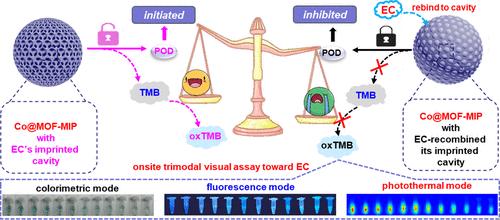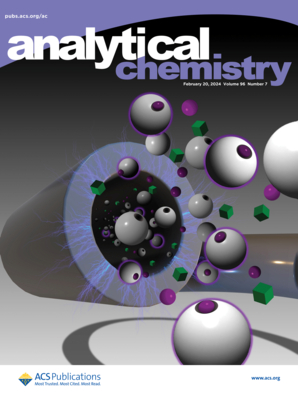基于可视分子印迹驱动的可切换纳米酶活性的氨基甲酸乙酯三模式检测和逻辑门电路
IF 6.7
1区 化学
Q1 CHEMISTRY, ANALYTICAL
引用次数: 0
摘要
对致癌物质氨基甲酸乙酯(EC)危害的担忧促使人们尝试利用高效、及时、直接和经济的检测方法来预警早期食品安全。在这里,我们提出了一种新型分子印迹聚合物 Co@MOF-MIP,它具有类似过氧化物酶(POD)的高活性和明亮的蓝色荧光发射,可用于开发一种多功能的视觉检测方法,对氨基甲酸乙酯进行比色、荧光和光热三重检测,并进行逻辑门输出。简而言之,Co@MOF-MIP 的 POD 类活性使其能将 H2O2 分解成 -OH,从而将无色的 3,3′,5,5′-四甲基联苯胺(TMB)氧化成蓝色的 oxTMB、通过内滤光片效应,Co@MOF-MIP 的蓝色荧光猝灭,从而产生 660 纳米波长的光热效应,观察到荧光信号减弱,比色信号和 660 纳米波长的光热效应信号增强。然而,EC 可特异性地填充 Co@MOF-MIP 的印迹空腔,将催化底物 TMB 和 H2O2 阻挡在 Co@MOF-MIP 外,使其无法与内部的 Co2+ 催化中心进一步反应,从而抑制 TMB 转化为 oxTMB,产生了 EC 浓度依赖性的荧光信号增强、比色和 660 纳米辐照光热信号减弱的三模反应。在智能手机和手持式热成像仪等便携设备的辅助下,提出了一种可视化现场便携式三模式分析平台,用于快速准确地检测导电率,比色、荧光和光热模式的检测限分别为 1.64、1.24 和 1.78 微克/升。有趣的是,这些反应事件可通过经典的布尔逻辑门分析进行编程,为大数据物联网监测和预警早期残留的氨基甲酸乙酯提供了一条更加智能、动态、快速和准确的新途径,保障了食品安全。本文章由计算机程序翻译,如有差异,请以英文原文为准。

A Versatile Visual Molecular Imprinting-Driven Switchable Nanozyme Activity-Based Trimodal Assay and Logic Gate Circuits of Ethyl Carbamate
Concerns regarding the hazard of the carcinogenic ethyl carbamate (EC) have driven attempts to exploit efficient, timely, straightforward, and economic assays for warning early food safety. Here, we proposed a novel molecularly imprinted polymer Co@MOF-MIP, with a high peroxidase (POD)-like activity and a bright blue fluorescence emission, to develop a versatile visual assay for colorimetric, fluorescent, and photothermal trimodal detection and logic gate outputting of EC. Briefly, the POD-like activity of Co@MOF-MIP made it to decompose H2O2 into ·OH for oxidizing colorless 3,3′,5,5′-tetramethylbenzidine (TMB) into a blue oxTMB, resulting in a 660 nm irradiated photothermal effect and bursting the blue fluorescence of Co@MOF-MIP via inner filter effect, observing a decreased fluorescence signal together with an increased colorimetric and 660 nm irradiated photothermal signals. However, EC could specifically fill the imprinted cavities of Co@MOF-MIP to block the catalytic substrates TMB and H2O2 out of Co@MOF-MIP for further reacting with the inside catalytic center of Co2+, resulting in the transformation suppressing of TMB into oxTMB, yielding an EC concentration-dependent trimodal responses in fluorescence signal enhancement, colorimetric, and 660 nm irradiated photothermal signal decreases. Assisted by the portable devices such as smartphones and hand-held thermal imagers, a visual onsite portable trimodal analytical platform was proposed for EC fast and accurate detection with the low detection limits of 1.64, 1.24, and 1.78 μg/L in colorimetric, fluorescent, and photothermal modes, respectively. Interestingly, these reactive events could be programmed by the classical Boolean logic gate analysis to offer a novel promising avenue for the big data Internet of Things monitoring and warning early residual EC in a more intelligent, dynamical, fast, and accurate manner, safeguarding food safety.
求助全文
通过发布文献求助,成功后即可免费获取论文全文。
去求助
来源期刊

Analytical Chemistry
化学-分析化学
CiteScore
12.10
自引率
12.20%
发文量
1949
审稿时长
1.4 months
期刊介绍:
Analytical Chemistry, a peer-reviewed research journal, focuses on disseminating new and original knowledge across all branches of analytical chemistry. Fundamental articles may explore general principles of chemical measurement science and need not directly address existing or potential analytical methodology. They can be entirely theoretical or report experimental results. Contributions may cover various phases of analytical operations, including sampling, bioanalysis, electrochemistry, mass spectrometry, microscale and nanoscale systems, environmental analysis, separations, spectroscopy, chemical reactions and selectivity, instrumentation, imaging, surface analysis, and data processing. Papers discussing known analytical methods should present a significant, original application of the method, a notable improvement, or results on an important analyte.
 求助内容:
求助内容: 应助结果提醒方式:
应助结果提醒方式:


